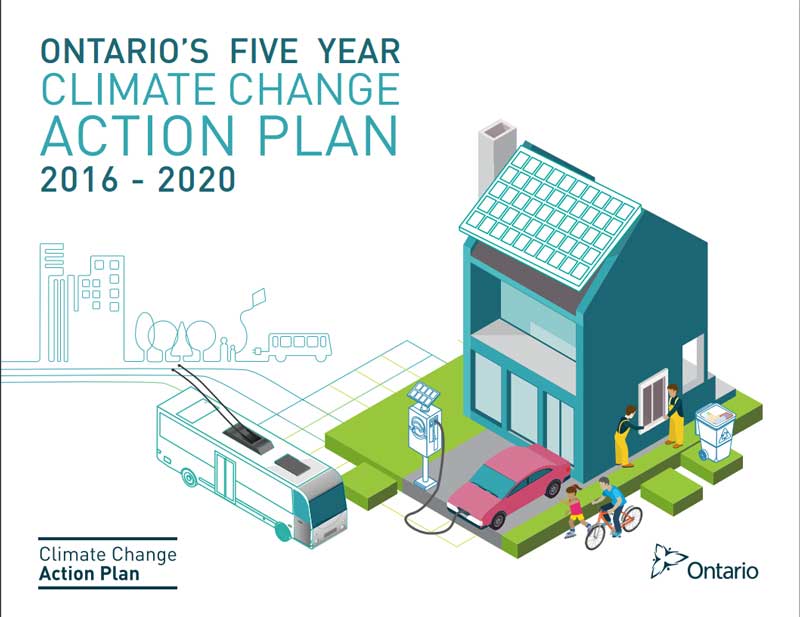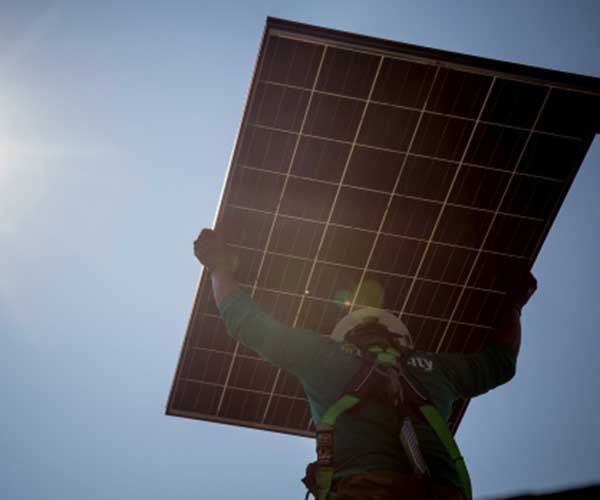Today’s release of Ontario’s Climate Change Action Plan marks another important milestone for the province’s ambitious strategy to tackle climate change and bring about a fundamental shift in the way people utilize energy. Ontario’s Climate Change Action Plan has a strong focus on solar and is putting the tools to realize this change where they belong, with businesses and individuals.
Ontario’s move to put a price on carbon through Cap and Trade was the correct first step. Accounting for the costs of carbon and limiting the amount of pollution in our air means that fossil fuels will be priced more appropriately.
It also means that the technologies that don’t rely on fossil fuels – solar energy, electricity storage and electric vehicles, to name a few – will step in to help individuals and industries reduce their dependence on those fuels. But making the switch from the old way of doing things to greener alternatives comes with a cost.
There is also a growing recognition that the Cap and Trade program won’t get Ontario to its aggressive greenhouse gas reduction goals all on its own. This is where the Climate Change Action Plan comes in.
The Climate Change Action Plan represents a comprehensive, economy wide, approach to meeting the challenge of climate change. Through the initiatives detailed in the plan, Ontarian’s will be given the tools and incentives they need to make the transition away from fossil fuels. By empowering people and companies to implement changes in how they use and generate energy the plan will allow more Ontarians to fuel switch to sustainable and zero emission forms of energy like solar.
It will allow people to heat their buildings and their water using solar thermal, it will allow them to generate their own electricity using solar PV, and importantly, it will allow them to save money while doing so. Some of the highlights of the Climate Change Action Plan for the solar industry include:
• Approximately $1.8 – 1.9 billion in overall program spending each year.
• Establishing a Green Bank to significantly increase the use of available technologies like solar, air-source heat pumps, geothermal systems, vehicle-to-grid energy systems, and energy storage systems.
• Support schools, hospitals, universities and colleges to improve energy efficiency and adopt renewable technologies like solar ($400 – 800 million).
• Help homeowners purchase and install low-carbon energy technologies such as geothermal heat pumps and air-source heat pumps, solar thermal and solar energy generation systems that reduce reliance on fossil fuels for space and water heating. This will include an increased benefit for low-income households and vulnerable communities ($500 – 600 million).
• Rebates will go to individuals who purchase or build their own near net zero carbon emission homes, with energy efficiency performance that sufficiently exceeds the requirements of the Building Code. In addition to reducing the higher upfront costs for homebuyers, this program will encourage construction of high-efficiency homes that pollute less ($180 – 220 million).
• Update the Building Code with long-term energy efficiency targets for new net zero carbon emission small buildings that will come into effect by 2030 at the latest, and consult on initial changes that will be effective by 2020. Ontario will consult on how to best achieve these targets through Building Code improvements (implementation in 2017/2018).
• Expand the Green Button program that lets Ontarians access and share their data on electricity, natural gas and water consumption in a secure, standardized electronic format. Expanding this tool province wide will help more households and businesses manage and conserve their energy and water use (implementation in 2017).
• Energy audits would be required before a new or existing single-family home can be listed for sale, and the energy rating will be included in the real estate listing. These audits are intended to be provided free of charge under this plan. The Home Energy Rating and Disclosure program will improve consumer awareness by allowing homebuyers to compare homes by energy rating ($200 – 250 million).
• Aggressive action on electrification of transportation including the construction of charging stations ($80 million), free overnight charging (implementation in 2016), and vehicle purchase incentives ($140-160 million).
• Collaborate with First Nation communities to implement microgrids and renewable energy, where feasible, to reduce dependence on diesel fuels.
• Establish low-carbon jobs and training partnerships among post-secondary institutions and Indigenous communities. These would deliver programs that would support skills training related to renewable energy, energy efficiency, and the green buildings sector.
• Reform existing policies and programs that support fossil fuel use and fossil fuel intensive technologies (implementation in 2017).
• Plan for any increased demand on the electricity grid as a result of greenhouse gas emissions reduction from measures such as the greater use of electric vehicles, and increased use of electricity for residential and commercial space and water heating (implementation in 2017/2018).
On behalf of our membership, CanSIA has been researching and developing policy and regulatory proposals in each of these areas through our Distributed Generation Task Force and our Ontario Solar Climate Change Initiative. We are pleased to see so many of our recommendations adopted by the government of Ontario.
As evidenced by the Climate Change Action Plan, solar is uniquely situated as a “lynch-pin” technology for combatting climate change. Solar electricity is versatile and scalable and acts as an enabler for electric vehicles and storage, allowing for electrification of other sectors of the economy without increasing greenhouse gas emissions.
Solar heating and cooling technologies and solar PV can be deployed in urban areas on people’s homes and businesses all the way up to larger systems for commercial and industrial applications to reduce their natural gas use.
Solar technologies are also seen as a critical component of any net zero building. The solar industry in Ontario has experience developing systems at all of these scales and will work with other sectors in finding solutions that work for their particular context.
From the provincial perspective, the programs, policies, and standards in the Climate Change Action Plan will also bring proven greenhouse gas reductions and green jobs to the province. A typical residential solar electricity installation offsets 3 Tonnes of GHG emissions. Each 1000 MW of distributed solar PV installed by individuals and businesses installed in Ontario over the next 5 years, would correlate to 14,500 person-years of employment and $2.5 billion of economic activity. These are not small numbers.
Many in Ontario remain skeptical about the economic opportunities clean energy offers, but the fact is that serious money-a third of a trillion dollars-was invested globally in renewable energy last year. The Ontario government is now seizing the opportunity to ensure that Ontarians have access to these technologies, and their value.
The Canadian Solar Industries Association and our members are primed to help Ontarians make this exciting transformation.
















Comments